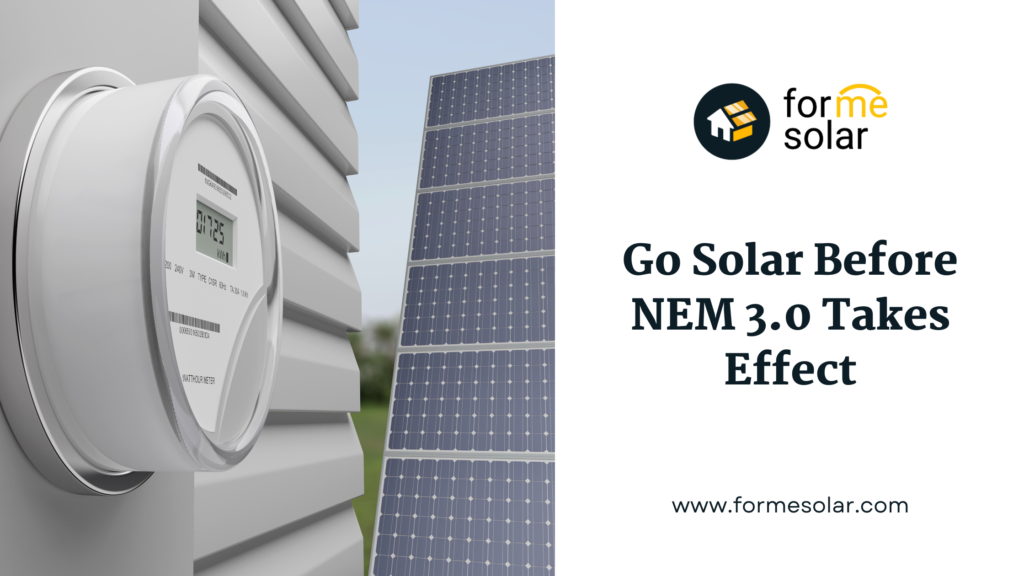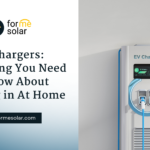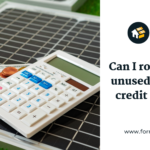
Table of Contents
Go Solar Before NEM 3.0 Takes Effect
The world is facing a global climate crisis, and one of the most effective ways to address this issue is through the adoption of renewable energy sources. Solar energy has been a popular choice for homeowners looking to lessen their carbon footprint and save money on their energy costs. Net Energy Metering (NEM) policies have been a significant driving force behind solar adoption, but changes are coming with the implementation of NEM 3.0. In this blog post, we will discuss what NEM is, what NEM 3.0 means for you, and why it's essential to consider going solar before the changes take effect.
What is Net Energy Metering (NEM)?
Net Energy Metering (NEM) is a billing arrangement that allows solar energy system owners to receive credit for excess electricity they generate and feed back into the grid. NEM policies enable homeowners to offset the cost of their electricity bills by crediting them for the excess energy produced by their solar panels. This system allows homeowners to earn credits on their electricity bills for generating more energy than they consume, which can significantly reduce the cost of their energy bills.
What does NEM 3.0 mean to you?
NEM 3.0 is a revision of the current NEM policies that are currently in effect in many states across the US. The revised policy will result in a reduction in compensation rates for solar energy system owners. NEM 3.0 will also allow utility companies to charge additional fees for grid usage and interconnection, which could result in higher costs for homeowners with solar panels. The primary goal of the policy change is to reduce the financial incentives for homeowners to switch to solar power and shift the cost of maintaining the grid onto solar customers.
What does NEM 3.0 mean for solar?
NEM 3.0 will cause a significant reduction in the export rate for residential solar electricity, lowering it from an average of 30 cents per kWh to only 8 cents per kWh. As a result, the payback period for solar owners will increase, and overall savings will decrease.
However, there is a silver lining to this situation. The new rate structure under NEM 3.0 has made battery storage integration more valuable and cost-effective. With the decreased export rate for residential solar electricity, the return on investment for solar and battery storage is now similar to that of solar-only systems. This means that investing in both solar and battery storage can provide homeowners with similar financial benefits, while also offering the added benefit of backup power during power outages or emergencies.
By installing battery storage with solar energy systems, homeowners can store excess solar energy for later use, rather than exporting it back to the grid at a low compensation rate. This not only maximizes the use of solar energy but also provides a reliable and independent source of backup power in case of emergencies or blackouts. The financial and practical benefits of battery storage have become even more compelling under NEM 3.0, and homeowners should consider this option to maximize their solar energy system investment.
How will NEM 3.0 be different?
The main difference between NEM 3.0 and the current NEM policies is the reduction in compensation rates for excess energy generated by solar panel owners. The new policy will compensate homeowners for their excess electricity at a lower rate, reducing the financial benefits of installing a solar system. In addition, utility companies will be allowed to charge additional fees for grid usage and interconnection. The exact rates have not yet been determined, but they are expected to be significantly lower than the current compensation rates.
When Will NEM 3.0 Take Effect?
NEM 3.0 is set to take effect in California after a 120-day grace period following its unanimous approval on December 15, 2022. This means that new solar energy customers after April 14, 2023, will be subject to the new NEM 3.0 policies.
Fortunately, Californians who wish to take advantage of the NEM 2.0 contract can still do so by applying for a solar interconnection before the start of NEM 3.0. Home and business owners can lock in their 20-year NEM 2.0 contracts by deciding to go solar before the April 2023 deadline passes, with a generous grace period of three full calendar years before the physical installation needs to be completed. This means that customers can still benefit from the NEM 2.0 policies until the end of 2025, offering them ample time to install their solar panels and take advantage of the current rates.
It's important to note that NEM 2.0 is a significant advantage to homeowners, especially when compared to the reduced export rate under NEM 3.0. By locking in the current rates, homeowners can enjoy a shorter payback period and greater overall savings. Therefore, if you're considering going solar, now is the best time to act and lock in NEM 2.0 rates before the deadline.
How NEM 3.0 will impact solar payback periods
One of the most significant impacts of NEM 3.0 will be on solar payback periods. The payback period is the amount of time it takes for a homeowner to recoup the initial investment in a solar energy system. With the reduction in compensation rates and the introduction of additional fees, the payback period for a solar energy system will increase. This means that it will take longer for homeowners to recoup their initial investment in a solar system, reducing the financial benefits of installing solar panels.
How to lock in NEM 2.0 rates
If you're considering going solar, now is the time to act. By installing a solar system before NEM 3.0 takes effect, you can lock in the current NEM 2.0 rates and benefit from the current compensation rates and lower fees for interconnection and grid usage. Here are some steps to take to lock in NEM 2.0 rates:
Research solar installers in your area: Start by researching local solar installers who can provide you with a quote and answer any questions you may have.
Get a quote: Once you've found a solar installer, request a quote for a solar system that meets your energy needs. Be sure to ask about the cost, financing options, and warranties.
Secure financing: Many solar installers offer financing options that can make it easier to afford the upfront cost of a solar system. Look for financing options with low-interest rates and favorable terms.
Schedule installation: Once you've secured financing, schedule the installation of your solar system. Be sure to ask your installer about the timeline for installation and any permits or paperwork required.
Conclusion
NEM 3.0 will have significant implications for solar power adoption in the US. The reduction in compensation rates and the introduction of additional fees will reduce the financial benefits of installing a solar system, making it less attractive for homeowners to switch to solar power. If you're considering going solar, now is the time to act. By installing a solar system before NEM 3.0 takes effect, you can lock in the current NEM 2.0 rates and benefit from the current compensation rates and lower fees for interconnection and grid usage.
Going solar not only saves you money on your electricity bill but also reduces your carbon footprint and supports the transition to renewable energy. With the help of NEM policies, homeowners can significantly reduce the cost of their electricity bills and contribute to a sustainable future. By taking advantage of NEM 2.0 rates, you can make the switch to solar energy while also benefiting from financial incentives that won't be available with NEM 3.0.
The transition to renewable energy is essential for combating climate change and creating a sustainable future. By going solar, you can take an active role in reducing your carbon footprint and supporting the growth of renewable energy. So, don't wait too long before it's too late! Act now, go solar, and lock in NEM 2.0 rates while they're still available.













